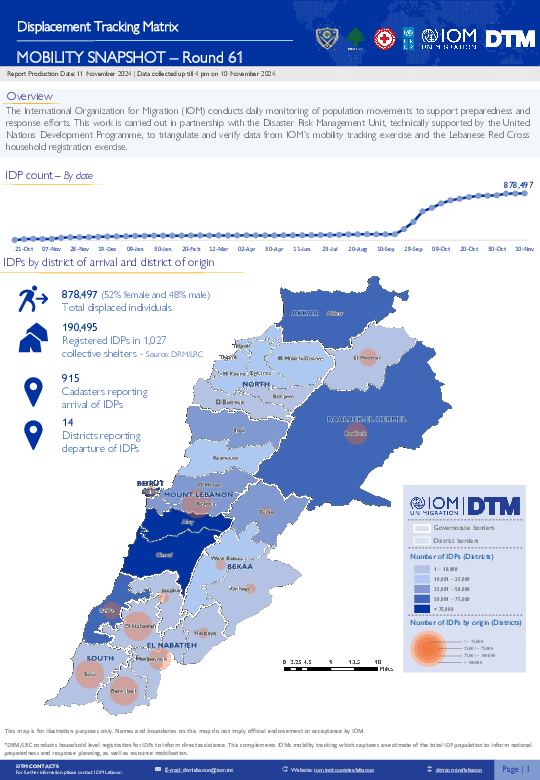-
Countries
-
Data and Analysis
-
Special Focus
-
Crisis Responses
Assessment Report

Contact
DTM Europe, DTMMediterranean@iom.int
Language
Bosnian, Croatian, Serbian
Location
Serbia
Period Covered
Oct 01 2024
Oct 31 2024
Activity
- Survey
- Flow Monitoring
Ovaj izveštaj pruža uvid u profile, iskustva i putovanja migranata koji prolaze kroz Republiku Srbiju. Podaci su prikupljani od 1. do 31. oktobra 2024. godine u saradnji sa Komesarijatom za izbeglice i migracije Republike Srbije (KIRS). Uzorak čini 205 migranata, anketiranih u centrima za azil (AC) Sjenica, (AC) Krnjaca, (AC) Obrenovac, te prihvatnim centrima (PC) Preševo i (PC) Bujanovac.

Contact
DTM Europe, DTMMediterranean@iom.int
Language
English
Location
Serbia
Period Covered
Oct 01 2024
Oct 31 2024
Activity
- Survey
- Flow Monitoring
This report provides insights into the profiles, experiences and journeys of migrants transiting through the Republic of Serbia. Data was collected from 1 to 31 October 2024 together with the Commissariat for Refugees and Migration of the Republic of Serbia (SCRM). The sample consists of 205 interviewed migrants in Asylum Centres (AC) Krnjaca, (AC) Sjenica, and Reception Centres (RC) Bujanovac, (RC) Presevo.

Contact
DTM Europe, DTMMediterranean@iom.int
Language
Macedonian
Location
North Macedonia
Period Covered
Jul 01 2024
Sep 30 2024
Activity
- Survey
- Flow Monitoring
Овој извештај, заснован на пристап со повеќе методи и повеќе извори, дава увид во профилите, искуствата, потребите, рутите и намерите на мигрантите кои транзитираат низ Република Северна Македонија. Од 1 јули до 30 септември 2024 година, енумераторите на ИОМ од програмата Displacement Tracking Matrix (DTM) анкетираа 446 мигранти во ПТЦ Винојуг и ПТЦ Табановце.

Contact
DTM Poland IOMDTMPoland@iom.int
Language
Ukrainian
Location
Poland
Period Covered
Mar 01 2023
Jan 01 2024
Activity
- Survey
У березні 2023 року МОМ Польща розпочала інтеграційне опитування, щоб оцінити прогрес і потреби, пов'язані з економічною та соціальною інтеграцією біженців з України в Польщі. Метою дослідження є розуміння ситуації з працевлаштуванням, житлом, фінансами, соціальними зв’язками, труднощами інтеграції, нагальними потребами і вразливістю українських біженців, а також змін, які відбулися з часом. Дослідження включає компонент довготривалого спостереження, в рамках якого учасники, які дали згоду, опитуються телефоном через 2-6 місяців після початкового опитування.
Цей звіт аналізує, як змінилася ситуація респондентів з часом, зосереджуючись на різних аспектах соціальної, трудової та економічної інтеграції. Перші опитування проводилися навесні та влітку 2023 року, а наступні — з літа до зими 2023-2024 років. Загалом у довготривалому компоненті взяли участь 160 респондентів.

Contact
DTM Poland IOMDTMPoland@iom.int
Language
Polish
Location
Poland
Period Covered
Mar 01 2023
Jan 01 2024
Activity
- Survey
W marcu 2023 r. IOM Polska rozpoczęła realizację sondażowego badanie integracji uchodźców z Ukrainy w Polsce. Pozwala ono monitorować postępy i potrzeby związane z integracją gospodarczą i społeczną, w tym w zakresie zatrudnienia, warunków mieszkaniowych, odporności finansowej, więzi społecznych, wyzwań integracyjnych, pilnych potrzeb, a także tego jak zmieniały się one w czasie.
Komponent podłużny niniejszego badania obejmował 160 respondentów sondażu przeprowadzonego wiosną 2023, którzy wyrazili zgodę i zostali powtórnie przebadani w okresie od 2 do 6 miesięcy po pierwszym wywiadzie. Niniejszy raport zawiera więc analizę tego, jak sytuacja respondentów zmieniała się na przestrzeni czasu, koncentrując się na różnych aspektach integracji społecznej, zawodowej i gospodarczej.

Contact
DTM Europe, DTMMediterranean@iom.int
Language
English
Location
North Macedonia
Period Covered
Jul 01 2024
Sep 30 2024
Activity
- Survey
- Flow Monitoring
This report, based on a multi-method and multi-source approach, provides insights into the profiles, experiences, needs, routes and intentions of migrants transiting through North Macedonia. From 1 July to 30 September 2024, IOM Displacement Tracking Matrix (DTM) enumerators surveyed 446 migrants at TTC Vinojug and TTC Tabanovce.

Contact
dtmlebanon@iom.int
Language
English
Location
Lebanon
Period Covered
Oct 10 2023
Nov 10 2024
Activity
- Mobility Tracking
- Baseline Assessment
Since October 8 there has been an increase in cross-border incidents between Israel and Lebanon, resulting in the displacement of people both within the South and elsewhere within the country. Since October 10, the Displacement Tracking Matrix (DTM) has been conducting the daily monitoring of population movements. The objective of the exercise is to inform preparedness and response planning.

Contact
dtmlebanon@iom.int
Language
English
Location
Lebanon
Period Covered
Oct 10 2023
Nov 06 2024
Activity
- Mobility Tracking
- Baseline Assessment
Since October 8 there has been an increase in cross-border incidents between Israel and Lebanon, resulting in the displacement of people both within the South and elsewhere within the country. Since October 10, the Displacement Tracking Matrix (DTM) has been conducting the daily monitoring of population movements. The objective of the exercise is to inform preparedness and response planning.

Contact
iomnigeriadtm@iom.int
Language
English
Location
Nigeria
Period Covered
May 16 2023
May 16 2023
Activity
- Mobility Tracking
- Event Tracking
On 16 May, windstorms struck GSSSS Camp and Banki Camp in Bama LGA of Borno State. The windstorms affected a total of 619 individuals from 133 households. The windstorms also damaged 78 shelters and five brick/block latrines.
The DTM (Displacement Tracking Matrix) field staff conducted quick evaluations in the wake of these events to provide the humanitarian community, the government, and partners with information and to enable a focused response. Direct observation and key informants are used in flash reports to collect representative data and learn about the number and immediate needs of affected communities.

Contact
iomnigeriadtm@iom.int
Language
English
Location
Nigeria
Period Covered
May 27 2023
May 28 2023
Activity
- Mobility Tracking
- Event Tracking
On 27 and 28 May 2023, heavy rainfall /windstorm struck GSSSS, Banki camps in Bama LGA, and Kiva host community in Gwoza LGA of Borno State, affecting a total of 800 individuals from 161 households. The incidents damaged 96 shelters and 42 latrines.
In response to these events, the DTM (Displacement Tracking Matrix) field team swiftly conducted evaluations to inform the humanitarian community, the government, and partners and to facilitate a targeted response. The field team utilized direct observation and key informant interviews in flash reports to collect representative data and determine the quantity and immediate needs of the affected groups.
Pagination
- Previous page
- Page 2
- Next page
